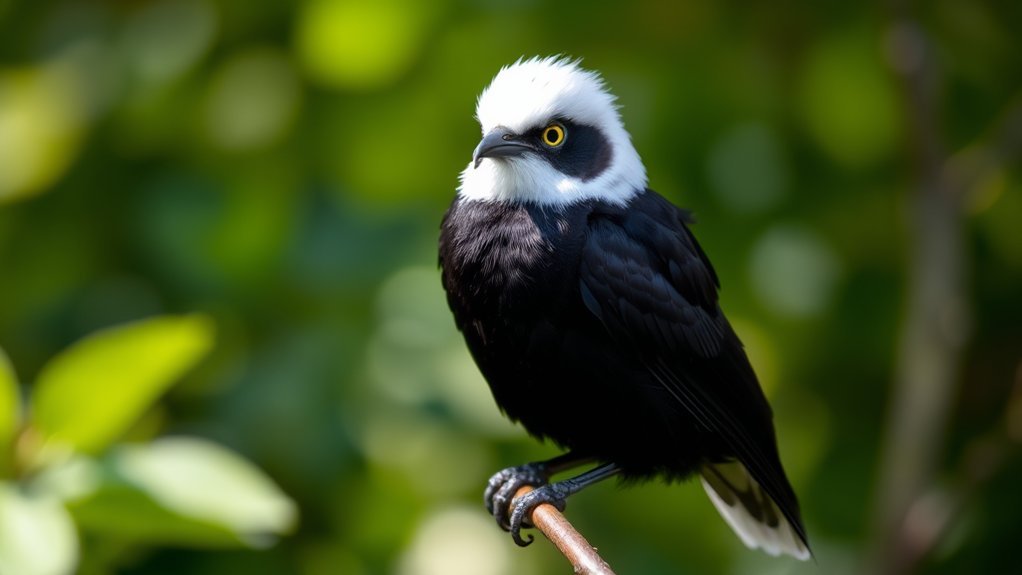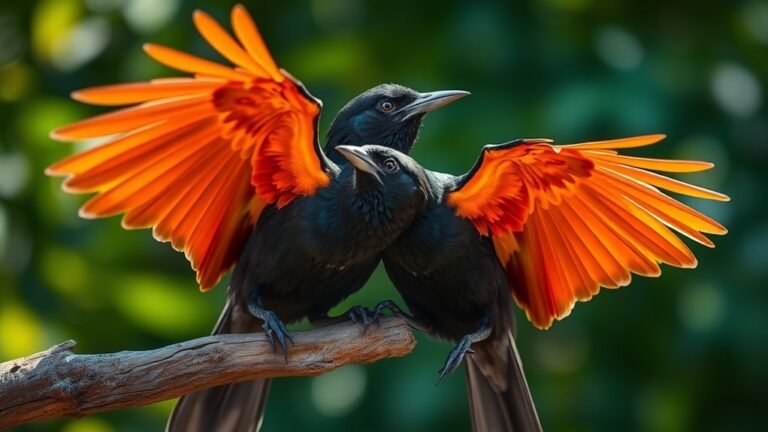White-Headed Bird With Black Body: Unique Species Guide
If you like birds with strong color contrasts, the white-headed, black-bodied bird is interesting. Their bright colors help attract mates and mark their territory. By looking at where they live, what they eat, and how they reproduce, you can see how they fit into their ecosystems. However, habitat loss poses a threat to their survival, making it important to understand their unique features. What challenges will they face in the future?
Key Takeaways
White-headed, black-bodied birds display bold color contrasts. This feature helps attract mates and support territorial behavior. Different species have varied feather patterns, which aid in identifying their age and health.
These birds live in forests, wetlands, and savannas, showing their ability to adapt to different environments. They eat fruits, seeds, and insects, and change their foraging habits based on the season.
Habitat loss poses a threat to their survival. Conservation efforts focus on protecting nesting areas and encouraging community participation to support these unique birds.
Overview of White-Headed, Black-Bodied Birds
When you see white-headed, black-bodied birds, their sharp color contrast catches your eye. The clear shift from their white crowns to their dark bodies makes them noticeable in any setting. This appearance affects how they attract mates and display their territory.
Beyond looks, these birds mean a lot in different cultures. They often represent purity or strength. Local stories often celebrate them, helping people connect with nature.
Common Species and Their Characteristics
When you observe white-headed, black-bodied birds, you'll notice clear features that help tell them apart.
Look closely at their feathers, as some have spots while others have stripes. These patterns help identify the birds and can even show their age or health.
When watching birds, pay attention to their behaviors and calls; some sing beautiful melodies, while others make loud sounds.
Notice how they move, whether they hop quickly among the trees or sit still.
Talking with other birdwatchers can make your experience more enjoyable and enrich your understanding of these fascinating birds.
Habitat and Distribution
Understanding where unique bird species live is key to appreciating their roles in nature. This striking bird thrives in various habitats, including forests, wetlands, and savannas. Its ability to adapt helps it flourish in different environments, often nesting in trees where food and shelter are plentiful.
The range of this black-bodied, white-headed bird spans areas known for high biodiversity. These regions play important roles in their ecosystems.
Feeding Behavior and Diet
The feeding behavior of this bird shows its adaptability and resourcefulness.
It uses various foraging techniques. For example, it looks for insects on tree bark and sweeps low over meadows for seeds. Its diet includes fruits, grains, and small invertebrates, which change based on the season and availability.
Observing this bird reveals its ability to adjust feeding methods according to the environment. It can forage alone or in small groups, indicating its connection to the ecosystem.
Understanding its diet and habits helps you appreciate this bird's role in nature. It contributes to maintaining ecological balance, making it a vital part of its habitat.
Mating and Reproductive Habits
During the mating season, birds exhibit courtship behaviors to attract partners. Males display their colorful feathers and perform flight stunts to impress females. These behaviors show they're healthy and strong, which are important traits for mating.
Once the birds form a pair, they build their nests in high places. They carefully gather twigs, grasses, and feathers to create a secure home for their future chicks.
Both parents work together to build the nest and care for the young. This teamwork strengthens their family bond and helps ensure their survival.
Conservation Status and Threats
Birds depend on their habitats for mating and nesting. These habitats are increasingly threatened by human activities like deforestation, urbanization, and farming.
Habitat destruction significantly risks bird populations.
Conservation efforts focus on protecting these crucial habitats. These efforts require the involvement of communities. Local conservation initiatives and policy advocacy build a sense of belonging and shared responsibility.
By adopting sustainable practices, individuals can help prevent habitat destruction. Supporting these actions helps maintain the balance that birds need to survive.
Every small effort contributes to protecting birds and their ecosystems, ensuring they thrive for the future.
Frequently Asked Questions
What Are Some Cultural Representations of These Birds?
Birds have significant symbolism in many cultures. They often represent freedom and spiritual connection. You can find their beauty reflected in art, literature, and folklore. These depictions invite you to consider deeper meanings and personal connections related to these birds.
How Can I Attract Them to My Backyard?
To attract birds to your backyard, set up bird feeders with their favorite seeds. Place nesting boxes around your yard as well. This will create a friendly space that invites birds to visit and makes your backyard lively and colorful. Enjoy watching them flock to your garden!
Do They Have Any Significance in Local Folklore?
In local folklore, these birds symbolize change and guidance. They play an important role in cultural rituals, helping to bring communities together. Engaging with their stories fosters connections among people, allowing you to dive into shared experiences and strengthen your community bonds.
What Are the Best Times for Birdwatching These Species?
The best times for birdwatching are early mornings and late afternoons. During these times, birds are most active. To observe them effectively, stay quiet and use binoculars. This will help you see them better and enjoy nature more.
How Can I Participate in Citizen Science for Bird Observation?
To participate in citizen science for bird observation, join local bird counting events. Use observation techniques such as point counts to gather data. Document your findings in a clear way. By doing this, you will contribute valuable data and meet fellow bird lovers. Enjoy the experience of learning about birds together.

Kashvi is a passionate bird enthusiast and nature lover who has been fascinated by the world of birds for years. With a keen eye for detail and a love for learning, Kashvi is dedicated to sharing her knowledge and insights with fellow bird enthusiasts on Avian Enthusiasts. Through her engaging and informative articles, Kashvi aims to inspire others to join her in exploring the fascinating world of birds and to promote a deeper appreciation for these incredible creatures.







